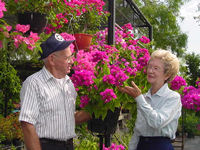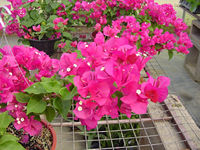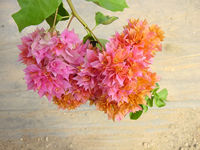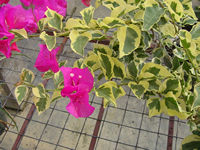|
by

Phil and Jean Hovey (deceased)
Please click on any image to enlarge
In 1768 when Admiral Louis
de Bougainvillea began his long journey to the Pacific Ocean and discovered
the vine that now bears his name, it was a botanical highlight of
the voyage. Through the ensuing years, this Brazilian beauty has assumed
its rightful place as one  of
the most popular, spectacular and beautiful tropical plants. The modern
day hybrids of Bougainvillea spectabilis (B. Brasiliensis)
and B. glabra are among the most beautiful of flowering vines.
These tropical members of the Nyctaginaceae (Four-O'Clock) family,
are very vigorous, evergreen,woody vines with spines. The plant is
unusual in several respects: it is sterile and propagated only from
cuttings, does better in pots than in the ground, and rewards our
neglect with abundant beauty. It bears no seeds, but mutates often,
resulting in many varieties. Grown either as a shrub or climbing vine,
it can summer on terraces, patios, decks, or at pool side. Although
normally climbers, they can be trained to stay bushy as pot plants,
hanging baskets, or as standard 3 or 4 feet high. They will bloom
beautifully on branches on 18"-20" long. Keep all long shoots cut
back to 18"-20" for best bloom. The vibrant color of this vine comes
not from the small white tubular flowers, but from the 3 large paper-like
bracts that surround each flower. of
the most popular, spectacular and beautiful tropical plants. The modern
day hybrids of Bougainvillea spectabilis (B. Brasiliensis)
and B. glabra are among the most beautiful of flowering vines.
These tropical members of the Nyctaginaceae (Four-O'Clock) family,
are very vigorous, evergreen,woody vines with spines. The plant is
unusual in several respects: it is sterile and propagated only from
cuttings, does better in pots than in the ground, and rewards our
neglect with abundant beauty. It bears no seeds, but mutates often,
resulting in many varieties. Grown either as a shrub or climbing vine,
it can summer on terraces, patios, decks, or at pool side. Although
normally climbers, they can be trained to stay bushy as pot plants,
hanging baskets, or as standard 3 or 4 feet high. They will bloom
beautifully on branches on 18"-20" long. Keep all long shoots cut
back to 18"-20" for best bloom. The vibrant color of this vine comes
not from the small white tubular flowers, but from the 3 large paper-like
bracts that surround each flower.
CULTURE
They grow readily from
cuttings 4"-6" long, and in 4-6  weeks
will develop good root systems when given bottom heat and mist. When
well rooted in perlite/peat moss mix, they can be potted in small
containers in a soilless mix with added pine bark to give more drainage.
Care should be exercised in transplanting since the fine roots often
do not knit the soil together in a firm root ball. When repotting
annually, slice off the outer 1"-2" of the root ball, and repot in
the same size container. Bougainvillea need very bright light (2,500
fc) and do well in full sun. These vines typically lose some leaves
for a short time during the winter, but when light conditions are
low, leaf loss may occur at any time. Under high light conditions,
the colorful bracts will adorn the plant almost constantly and will
persist for weeks. Planting in the ground in San Antonio is not weeks
will develop good root systems when given bottom heat and mist. When
well rooted in perlite/peat moss mix, they can be potted in small
containers in a soilless mix with added pine bark to give more drainage.
Care should be exercised in transplanting since the fine roots often
do not knit the soil together in a firm root ball. When repotting
annually, slice off the outer 1"-2" of the root ball, and repot in
the same size container. Bougainvillea need very bright light (2,500
fc) and do well in full sun. These vines typically lose some leaves
for a short time during the winter, but when light conditions are
low, leaf loss may occur at any time. Under high light conditions,
the colorful bracts will adorn the plant almost constantly and will
persist for weeks. Planting in the ground in San Antonio is not  recommended
because of the winter damage which will result, and the fact that
our soils are too rich and we receive too much rain. In the ground,
the plant will stay vegetative and bloom little. A better option is
to "plant" the potted bougainvillea plant in the landscape so the
root system will be inhibited. Continuous pinching of the tips of
the new shoots will encourage branching. The plants can be cut back
to 12 inches in the spring and fall and encouraged to make new growth.
They bloom on new growth, so try to make as many new growth points
as possible by a pinching often. In a hanging basket or other container,
try at all costs to avoid the long 6 foot shoots by pinching often.
After pinching, if the night temperatures are at least 70 degrees
F., bloom can be expected in about 50 days. In late fall, you will
have to make arrangements to protect your bougainvillea from cold
temperatures (below 40 degrees F.) If you have a greenhouse, move
it in when the 40 degree F. temperatures arrive. The tropical blooming
machine will be colorful all winter if you keep the greenhouse temperatures
between 50 degrees F. And 110 degrees. F. If you do not have a greenhouse,
move the bougainvillea into the house or insulated garage. The plant
has thorns and can be difficult to store unless it is pruned back
to 6- to 8-inch stems. Phil Hovey recommended that you tie up the stems for
storage rather than do the severe pruning in the fall.
The tying tactic reduces the tendency for the plants
going into storage to put on a flush of growth. Hovey does his pruning
in March when he moves the plants back out into the nursery. Every
two years, or when you notice a diminished performance, consider repotting
bougainvilleas. Remove the root ball from the container, select a
sturdy knife, and cut a one inch strip all the way around the ball.
Toss the trimmed strip into the compost pile, replace the root ball
in the container, and fill the container with new potting soil. recommended
because of the winter damage which will result, and the fact that
our soils are too rich and we receive too much rain. In the ground,
the plant will stay vegetative and bloom little. A better option is
to "plant" the potted bougainvillea plant in the landscape so the
root system will be inhibited. Continuous pinching of the tips of
the new shoots will encourage branching. The plants can be cut back
to 12 inches in the spring and fall and encouraged to make new growth.
They bloom on new growth, so try to make as many new growth points
as possible by a pinching often. In a hanging basket or other container,
try at all costs to avoid the long 6 foot shoots by pinching often.
After pinching, if the night temperatures are at least 70 degrees
F., bloom can be expected in about 50 days. In late fall, you will
have to make arrangements to protect your bougainvillea from cold
temperatures (below 40 degrees F.) If you have a greenhouse, move
it in when the 40 degree F. temperatures arrive. The tropical blooming
machine will be colorful all winter if you keep the greenhouse temperatures
between 50 degrees F. And 110 degrees. F. If you do not have a greenhouse,
move the bougainvillea into the house or insulated garage. The plant
has thorns and can be difficult to store unless it is pruned back
to 6- to 8-inch stems. Phil Hovey recommended that you tie up the stems for
storage rather than do the severe pruning in the fall.
The tying tactic reduces the tendency for the plants
going into storage to put on a flush of growth. Hovey does his pruning
in March when he moves the plants back out into the nursery. Every
two years, or when you notice a diminished performance, consider repotting
bougainvilleas. Remove the root ball from the container, select a
sturdy knife, and cut a one inch strip all the way around the ball.
Toss the trimmed strip into the compost pile, replace the root ball
in the container, and fill the container with new potting soil.
FERTILIZATION
 These vines are heavy feeders and respond best to constant (daily) feeding with one-half strength water soluble fertilizer, e.g., Peter's 20-20-20, Excel 21-5-20, Miracle Grow or Rapid Grow. With high light and constant feeding, the plants will bloom at least 11 months of the year. Straight hibiscus food has also been a very successful fertilizer. These plants are salt tolerant so constant fertilization will not create a problem.
These vines are heavy feeders and respond best to constant (daily) feeding with one-half strength water soluble fertilizer, e.g., Peter's 20-20-20, Excel 21-5-20, Miracle Grow or Rapid Grow. With high light and constant feeding, the plants will bloom at least 11 months of the year. Straight hibiscus food has also been a very successful fertilizer. These plants are salt tolerant so constant fertilization will not create a problem.
WATERING
These plants flower best
under stress. Keep the plant slightly on the dry side, and allow the
plant to become root bound. In containers they should be watered frequently
so the soil feels nicely moist but never soggy. Water thoroughly,
then allow to become moderately dry between waterings. They respond
extremely well to stress, such as drought and heat, and reward you
with excellent bloom. Even with a tolerance for drought, however,
you end up watering plants nearly every day because of the small root
system. Irrigate enough at each watering so that the water comes through
the drain holes in the bottom of the container.
INSECTS
Bougainvilleas are almost
totally insect free. The occasional "cabbage looper" or aphid can
be treated with the appropriate pesticide.
BEST VARIETIES
The blooms as we know
them are not true flowers, but are 3 large papery bracts that encircle
small, white, tubular inconspicuous flowers much like the poinsettia.
Some of the best bougainvilleas to look for in your local garden centers
are: white and lavender 'Dr. Barry',, and its gold and
green leaved variegatedfrom 'Vickie', the dark pink
flowers of 'Juanita Hatten', and its new mutation with
green leaves spatter painted with gold. 'Barbara Karst'
Bright red to bluish crimson in shade, blooms very young, likes heat.
'Sundown' Apricot color, vigorous, good bloomer, heavy
feeder. 'Hawaiian Torch' fuchsia, with compact bloom
arranged around a spike. 'Texas Dawn' smaller pink flowers,
in huge clusters, vigorous, keep cut back. 'Double Pink'
clear pink, vigorous, keep trimmed back, spent flowers must be cut
off since double flowering types will not shed flowers in the typical
fashion. 'Surprise' large, clear pink-white bi-color
flowers, easy bloomer. Excellent! 'Royal Purple' the
most striking purple flowers on the market, easy bloomer.
GROWING IN CONTAINERS
Plants do best in large
(5-10 gallon) clay containers if grown outdoors (clay containers tend
to stay drier, thus stressing the plants) or in large handing baskets.
The 10" basket is the commercial standard, but plants will do much
better in 12" hanging baskets. Place the containers in full sun, or
in a place where they will receive at least ½ day of full sun. If
your bougainvillea is not blooming, it probably is not receiving enough
sun or fertilizer. These plants thrive in the tropics in areas of
low rainfall and intense sun and heat. Any well drained pottingsoil
mix is suitable for growing Bougainvillea. Hatten's Nursery in Mobile,
Alabama, world famous bougainvillea growers use a mix consisting of
4 parts of well rotted pine bark, 3 parts peat moss and 2 parts of
coarse perlite. To about 5 gallons of this mix add ½ cup of Osmocote
and 2 tablespoons of 19-5-9 slow release lawn fertilizer.
|



